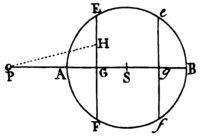on of the forces, the proportions remaining as before.
Cor. 6. If ſpheres of this kind revolve about others at reſt, each about each; and the diſtances between the centres of the quieſcent and revolving bodies are proportional to the diameters of the quieſcent bodies; the periodic times will be equal.
Cor. 7. And again, if the periodic times are equal, the diſtances will be proportional to the diameters.
Cor. 8. All thoſe truths above demonſtrated, relating to the motions of bodies about the foci of conic ſections, will take place, when an attracting ſphere, of any form and condition like that above deſcribed, is placed in the focus.
Cor. 9. 9. And alſo when the revolving bodies are alſo attracting ſpheres of any condition like that above deſcribed.
Proposition LXXVII. Theorem XXVIII.
If to the ſeveral points of ſpheres there tend centripetal forces proportional to the diſŧances of the points from the attracted bodies; I ſay that the compounded force with which two ſpheres attract each other mutually is or the diſŧance between the centres of the ſpberes.

Case 1. Let AEBF (Pl. 22. Fig. 2.) be a ſphere; S its centre; P a corpuſcle attracted; PASB the axis of the ſphere pulling through the centre of the corpuſcle; EF, ef two planes cutting the ſphere, and perpendicular to the axis, and
